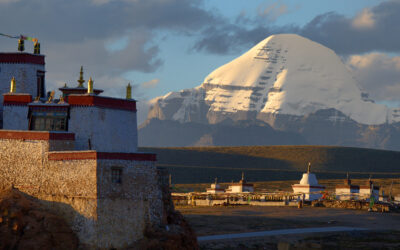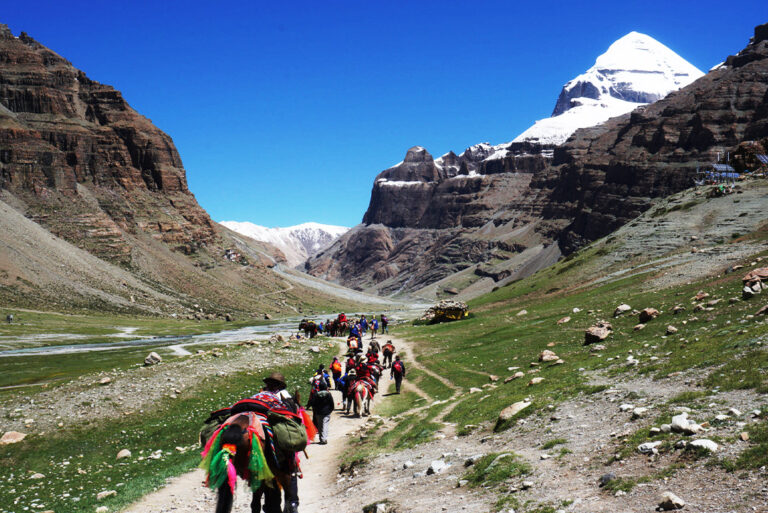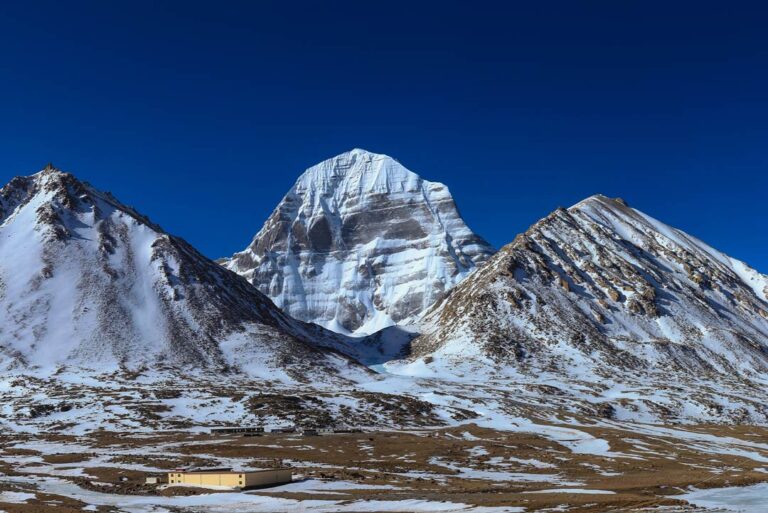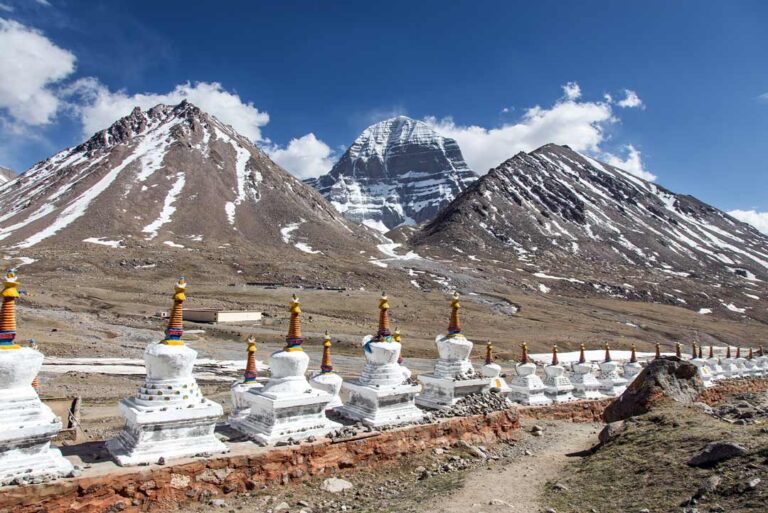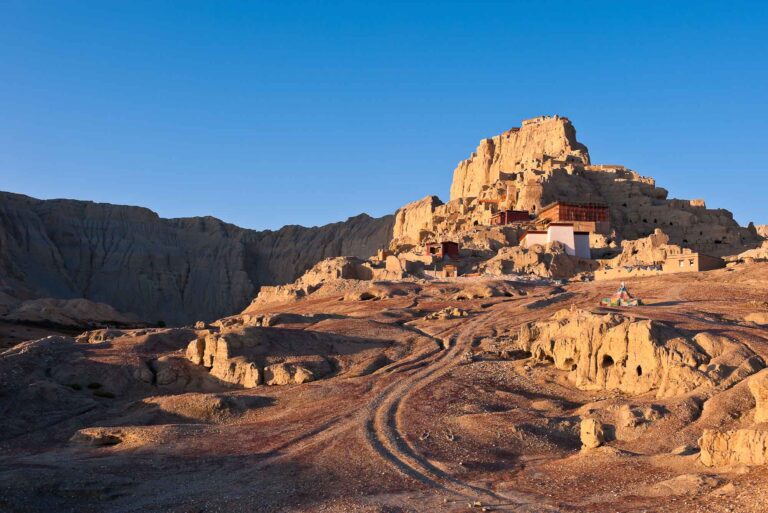Kailash – The Abode of Shiva. Nestled amid the panoramic landscapes of Tibet, Mount Kailash stands as a beacon of spiritual enlightenment where the threads of Hindu, Buddhist, and yogic traditions intricately weave together. This sacred mountain, shrouded in an ethereal mist, is not merely a geographical wonder but a living testament to the spiritual fabric that transcends religious boundaries. Mount Kailash is a magnetic center, drawing seekers from diverse backgrounds who are lured by the promise of accessing profound spiritual wisdom. The convergence of these ancient traditions at this sacred site creates a unique energy field, a resonance that echoes the collective aspirations for higher understanding and divine connection.
As the journey unfolds towards the base of Mount Kailash, the air becomes thick with a sense of reverence and anticipation. Pilgrims and seekers, driven by an innate desire for spiritual transcendence, navigate the rugged terrain, not merely to conquer a physical peak but to unravel the mysteries held within the mountain’s spiritual depths. Mount Kailash is not merely a destination; it is an embodiment of spiritual teachings and mystical experiences that have been deposited and preserved throughout the ages. The pilgrims’ footsteps echo the countless seekers who have walked this sacred path, seeking not just a summit but a communion with the timeless wisdom that resides within the very soul of Mount Kailash.

The Spiritual Library of Kailash: Kailash – The Abode of shiva
Within the sacred contours of Mount Kailash, a mystical repository transcends the tangible landscape, manifesting as a spiritual library of unparalleled significance. Here, the ethereal presence of great beings, with Shiva at the forefront, intertwines with the very essence of the mountain. It goes beyond a physical entity, resonating with the collective wisdom and spiritual energies bestowed upon it over centuries. This sacred space serves as a beacon for seekers and mystics, offering sanctuary from the tumultuous pace of human existence. The knowledge and energy deposited within this spiritual library become a timeless offering, inviting those with a genuine quest for enlightenment to partake in its profound teachings.
Amidst the rugged terrain and awe-inspiring beauty of Mount Kailash, the repository stands as a testament to the commitment of mystics to preserve their spiritual legacies. The intentional inaccessibility of this sacred space is not a deterrent but a deliberate choice, ensuring that only those earnestly seeking spiritual elevation venture forth. It becomes a retreat from the noise of the world, a secluded haven where mystics deposit their profound insights, safeguarding them from the disruptions of societal constraints. This spiritual library, hidden within the folds of Kailash, beckons to those attuned to its energy, offering a timeless connection to the divine and an opportunity to unravel the mysteries of existence in the solitude of its spiritual sanctuary.
The Story of Rishabdev
The story of Rishabdev unfolds as a testament to the profound impact Mount Kailash exerts on those who seek its divine energy. Rishabdev, revered as the first Jain Thirthankar, embarked on a mission to Kailash driven by the allure of the knowledge and energy associated with this sacred mountain. However, upon reaching its majestic peaks, Rishabdev underwent a profound inner transformation. The overwhelming spiritual energy of Kailash left an indelible mark on his consciousness, compelling him to abandon the initial intention of extracting knowledge for personal gain.
In a radical shift of purpose, Rishabdev chose a path of unity with the mountain, merging his being with the sacred terrain. This decision symbolizes a relinquishment of personal ambitions in favor of a higher spiritual calling. It reflects the irresistible temptation that Kailash presents, inviting seekers to move beyond the pursuit of individual knowledge and immerse themselves in the boundless energy that permeates the mountain. Rishabdev’s story, therefore, becomes a timeless illustration of the transformative potential inherent in the mystical embrace of Mount Kailash, where the human quest for enlightenment converges with the divine energy residing within the sacred peaks.
Shiva as the Adiyogi
In the yogic culture, Shiva transcends the conventional perception of a deity, assuming the profound role of the Adiyogi—the primordial yogi and the first guru. Far beyond the confines of religious dogma, this depiction casts Shiva as the eternal source of yogic wisdom and spiritual enlightenment. The title “Adiyogi” encapsulates the essence of Shiva as the pioneer who delved into the intricacies of the yogic sciences and transmitted this profound knowledge to his first seven disciples, known as the Saptarishis. Shiva, in this cultural context, becomes the embodiment of the transformative power of yoga, symbolizing the path to self-realization and ultimate liberation.
The symbolic association of Shiva with Mount Kailash as his abode holds a deeper significance within the yogic narrative. It suggests that the expansive knowledge, spiritual prowess, and capabilities that Shiva encompasses have been energetically imprinted on the sacred terrain of Mount Kailash. This energetic deposition transforms Kailash into a reservoir of yogic wisdom, offering seekers a unique opportunity to tap into the vibrational frequencies that reverberate with the very essence of Adiyogi Shiva. Thus, the pilgrimage to Mount Kailash is not a mere physical journey but a spiritual quest to connect with the profound yogic legacy that Shiva, as the Adiyogi, has left embedded in the heart of this majestic mountain.
Kailash as the Axis of Existence
Kailash’s recognition as the axis of existence goes beyond its physical location, expanding its sacred influence across diverse regions and cultures. From the Far-east Asian countries, where ancient spiritual practices intertwine with profound reverence for sacred landscapes, to the Middle East, where diverse spiritual traditions have flourished, Mount Kailash stands as a universal symbol. The magnetic pull of its spiritual energy draws pilgrims and seekers alike, fostering a shared acknowledgment of Kailash’s significance in the collective consciousness of humanity. Its role as the axis resonates not only in the geographical landscape but also in the spiritual tapestry that spans continents, linking individuals and communities through a shared recognition of the mountain’s divine aura.
The sacredness attributed to Kailash becomes a cultural and spiritual bridge, connecting people across the vast expanse of Asia. Its symbolic importance is woven into the fabric of belief systems, fostering a sense of unity among diverse cultures. Pilgrims who embark on the journey to Kailash find themselves participating in a collective pilgrimage that transcends national and cultural boundaries, reaffirming the mountain’s role as a unifying force in the rich tapestry of human spirituality. In this way, Mount Kailash stands as an enduring testament to the interconnectedness of spiritual traditions and the universal quest for divine understanding.
Mystics Choosing Kailash
Mystics from various spiritual traditions across history have been drawn to Mount Kailash as a sacred haven for the preservation of their profound insights and spiritual contributions. Rishabdev, the first Jain Thirthankar, embarked on a mission to Kailash with the intention of assimilating the mountain’s divine energy into his being, choosing to become a part of this spiritual repository rather than merely extracting knowledge for personal gain. Similarly, the saints of the Bon religion recognized the unique energy signature of Kailash and entrusted their sacred teachings to its ethereal embrace. Great Buddhist teachers like Milarepa, echoing the sentiment, have also sought to eternally embed their wisdom within the vast spiritual library that is Mount Kailash.
The strategic remoteness of Mount Kailash serves a dual purpose in safeguarding the sanctity of the spiritual depository. On one hand, this seclusion ensures that only those sincere and dedicated seekers who are willing to undergo the arduous pilgrimage will have access to the profound knowledge embedded within the mountain. On the other hand, the challenging terrain and isolation naturally discourage casual visitors, preserving the sacredness of the site and preventing its exploitation for commercial or superficial purposes. In this way, Mount Kailash stands not only as a physical peak but as a beacon of spiritual wisdom, carefully guarded by its remoteness to maintain the authenticity and transformative power of the knowledge deposited by mystics throughout the ages.
Pilgrimage to Kailash
Pilgrimage to Mount Kailash or Kailash Manasarovar Yatra is not just a physical journey but a profound spiritual endeavor that encapsulates the ancient concept of pilgrimage. It goes beyond mere physical travel, involving a transformative process where individuals willingly subject themselves to rigorous physical and mental challenges. The essence of this pilgrimage lies in the intentional subjugation of the ego, a practice deeply embedded in the rich tapestry of spiritual traditions. Pilgrims embark on this arduous journey with the understanding that overcoming the challenges posed by Kailash’s rugged terrain is not just a physical feat but a symbolic conquest of the inner self.
In stark contrast to contemporary, more comfortable approaches to sacred destinations, the pilgrimage to Kailash retains the raw, untamed nature of ancient spiritual journeys. In an era where convenience often defines our experiences, Kailash stands as a testament to the enduring power of hardship in fostering spiritual growth. The challenging terrain serves as a crucible, forging a deep connection between the pilgrim and the spiritual significance of the journey. It is in the struggle against the elements, the altitude, and the physical demands of the path that pilgrims find themselves humbled, realizing that the pilgrimage is not just a physical endeavor but a transformative inner exploration, echoing the timeless wisdom of ancient spiritual practices.
Relevance in Modern Societies
In modern societies, characterized by a plethora of comforts and conveniences, the fundamental idea of pilgrimage gains renewed relevance. The conveniences of contemporary life, while providing ease and efficiency, have inadvertently contributed to a decline in physical strength and resilience. As individuals find themselves increasingly immersed in a sedentary lifestyle, disconnected from the natural world, the call to embark on a pilgrimage becomes a powerful antidote. The journey to Mount Kailash stands as a symbolic return to the elemental challenges of nature, requiring pilgrims to navigate rugged terrains and endure physical hardships. This contrast with the comfort-driven modern lifestyle is a wake-up call, prompting individuals to reassess their priorities and rediscover the strength and resilience inherent in the human spirit.
The pilgrimage to Mount Kailash is not merely a physical undertaking but a transformative spiritual quest. In a world where the pursuit of material success often overshadows spiritual well-being, the challenges posed by the sacred journey become a catalyst for profound inner growth. Pilgrims, stepping out of their comfort zones, find themselves humbled by the formidable terrain, fostering a sense of humility and self-awareness. The inherent difficulties of the pilgrimage serve as a medium through which individuals can shed the superficial layers of modern living, allowing for a deeper connection with their inner selves and the spiritual essence of Mount Kailash. Thus, in the context of contemporary society, the pilgrimage to Mount Kailash emerges as a timeless and relevant pathway to rediscover the strength, resilience, and spiritual depth that modern comforts often obscure.
The Temptation of Immortality
The Temptation of Immortality at Mount Kailash goes beyond a mere invitation—it’s an encounter with the ineffable. As seekers delve into the profound energy resonating through the mountain, a compelling notion of transcending mortality unfolds. The magnetic force of Kailash weaves a narrative that beckons individuals to ponder their existence beyond the ordinary constraints of time. It’s not merely a fleeting temptation but a deep, existential pull that ignites contemplation about merging one’s essence with the eternal energy encapsulated within the sacred peaks.
This allure resonates with the age-old human yearning for immortality, a desire rooted in the very fabric of our being. The transformative energy of Kailash serves as a catalyst, challenging conventional perceptions of life and mortality. The mountain becomes a threshold, inviting those who are touched by its spiritual essence to consider the possibility of a timeless connection with the divine. This profound experience opens a doorway to a realm where the temporal boundaries of life blur, and the aspiration for immortality becomes a tangible, albeit elusive, prospect for those fortunate enough to embark on this spiritual journey.
The Transformative Nature of Pilgrimage
The transformative nature of pilgrimage extends beyond the mere act of reaching a sacred destination. It involves a profound process of self-discovery and self-subjugation, where individuals willingly subject themselves to the challenges of the journey. The pilgrimage to Mount Kailash, with its arduous terrain and demanding conditions, becomes a crucible for personal growth and transformation. The physical trials, such as trekking through rugged landscapes and braving harsh weather, parallel the mental and emotional challenges inherent in the quest for spiritual enlightenment. As pilgrims navigate these difficulties, they are compelled to confront their own limitations and redefine their relationship with the world, fostering a profound sense of humility and self-awareness.
The integral role of physical and mental hardships in the spiritual journey to Mount Kailash lies in their ability to strip away the layers of ego and self-importance. The challenging pilgrimage acts as a catalyst for inner growth, pushing individuals beyond their comfort zones and forcing them to grapple with their vulnerabilities. This transformative process is not just about reaching a physical destination but about shedding the burdens of the self, allowing pilgrims to emerge with a renewed perspective on life. The sacredness of Mount Kailash, combined with the transformative nature of the pilgrimage, creates a potent spiritual alchemy that has the potential to leave a lasting impact on the pilgrim’s consciousness, fostering a deeper connection with the divine and a profound understanding of one’s place in the universe.
The Volume and Variety of Knowledge
The expansive repository of wisdom and insights nestled within Mount Kailash transcends the boundaries of any singular tradition. The mountain, often analogized as a spiritual library, echoes with the accumulated knowledge of mystics from diverse spiritual traditions. These mystics, whether Hindu, Buddhist, or practitioners of the Bon religion, have recognized the profound energy of Kailash as a conduit for preserving and disseminating their invaluable insights. It’s not merely a physical space but a metaphysical realm where the teachings of different paths converge, creating a tapestry of spiritual understanding. The volume and variety of knowledge housed in Kailash reflect the universality of its appeal and the inclusive nature of its spiritual embrace, drawing seekers from myriad backgrounds into its transformative energy.
As a sanctuary for spiritual exploration, Kailash stands as a testament to the collective aspirations of mystics who sought to share their profound experiences with humanity. The richness of this spiritual repository goes beyond the written or spoken word, encompassing the energy and vibrations embedded in the very fabric of the mountain. Those who undertake the pilgrimage to Kailash are not only exposed to the intellectual aspects of this vast knowledge but also experience a direct communion with the subtle forces that permeate the sacred site. It serves as a living testament to the notion that wisdom, in its myriad forms, can be both preserved and transmitted through the dynamic interplay between the seekers and the spiritual energy enshrined in the hallowed grounds of Mount Kailash.
The Decline of Awareness
The decline of awareness surrounding Mount Kailash in recent centuries can be attributed to various factors, including shifts in societal values, changes in cultural practices, and a general waning interest in traditional spiritual sites. As the world undergoes rapid modernization, ancient sacred places like Kailash often face the risk of fading into obscurity. The diminishing awareness is particularly concerning given the wealth of spiritual knowledge and energy associated with Kailash. In an era where technology and urbanization dominate, the spiritual significance of such sites tends to be overshadowed by more immediate and tangible concerns.
Despite this decline, there still exist small groups of individuals who actively recognize and uphold the significance of Mount Kailash. These custodians of spiritual wisdom are essential in preserving the legacy of Kailash and ensuring that its profound teachings continue to inspire and guide seekers. The challenge ahead lies in finding innovative ways to bridge the gap between the ancient wisdom of Kailash and the contemporary world. Through education, outreach, and fostering a deeper understanding of the spiritual heritage embedded in such sacred spaces, there is hope that the awareness of Mount Kailash can be revitalized and passed down to future generations, securing its place as a beacon of spiritual enlightenment.
The Challenge of Perception
The Challenge of Perception for mystics went beyond personal experiences; it encompassed the daunting task of preparing individuals to receive profound knowledge. Society, with its preconceived notions and restrictions, posed a formidable obstacle to the transmission of spiritual wisdom. The prevailing norms and societal expectations often limited the extent to which mystics could openly share their insights. Moreover, individual limitations, both psychological and physiological, added another layer of complexity. The receptivity of individuals varied greatly, making it a challenge for mystics to find those genuinely prepared to delve into the depths of spiritual understanding.
In response to these challenges, mystics strategically chose secluded locations like Mount Kailash to deposit their work. The inherent difficulty in reaching such places served as a natural filter, ensuring that only those truly committed and ready to receive the profound teachings would make the journey. By doing so, mystics aimed not only to preserve their spiritual knowledge but also to create an environment where seekers could engage with the teachings without the interference of societal biases. This approach allowed for a more direct and personal connection between the seeker and the spiritual wisdom stored in these sacred spaces, fostering a profound and transformative experience for those willing to embark on the journey.
The Fundamental Idea of Pilgrimage
The fundamental idea of pilgrimage, rooted in the pursuit of subduing one’s ego, has undergone a transformative evolution over the ages. In ancient times, pilgrimage was a rigorous undertaking, demanding individuals to traverse challenging terrains, endure physical hardships, and exhibit unwavering self-discipline. These ancient pilgrimages were not merely physical journeys; they were profound spiritual quests designed to break down the barriers of ego, fostering humility and inner transformation. Pilgrims engaged in practices that tested their resilience, providing a unique opportunity for self-discovery and connection with the divine. The rigors of the journey were seen as essential elements in stripping away the layers of the ego, allowing pilgrims to approach sacred destinations with a purified and receptive heart.
In contrast to these ancient traditions, modern approaches to pilgrimage have witnessed a shift towards more comfortable and convenient experiences. Advances in transportation and infrastructure have made sacred sites more accessible, altering the dynamics of the spiritual journey. While contemporary pilgrimages may lack the physical challenges of their predecessors, the core essence of seeking spiritual growth and connection remains intact. The continued relevance of the spiritual journey is emphasized, urging individuals to explore the inner landscapes of their consciousness and navigate the complexities of the ego in a modern context. Despite the evolution in the external aspects of pilgrimage, the intrinsic purpose of subduing one’s ego and attaining spiritual enlightenment endures as a timeless and universal quest.
The Greatest Pilgrimage
The journey to Mount Kailash is not just a physical trek; it is a soul-stirring odyssey that transcends cultural boundaries. Pilgrims from diverse traditions converge on this sacred site, drawn by the profound spiritual energy that permeates the mountain. The very act of undertaking the pilgrimage to Kailash signifies a deep commitment to spiritual growth and self-discovery. Pilgrims navigate the challenging terrain with unwavering determination, facing physical and mental hardships that mirror the inner struggles on their spiritual journey. The mystique surrounding Mount Kailash amplifies its allure, creating an atmosphere charged with reverence and awe. This spiritual magnetism resonates with the pilgrims, fostering a sense of unity and shared purpose, transcending the differences in their cultural backgrounds.
Mount Kailash’s role as a repository of spiritual wisdom further enhances its status as the greatest pilgrimage destination. The mountain not only symbolizes the ancient teachings and insights of revered figures like Shiva but also serves as a living testament to the perseverance and devotion of those who seek its divine essence. As pilgrims navigate the rugged path to Kailash, they not only embark on a physical journey but also delve deep into the recesses of their own consciousness. The profound experiences and insights gained during this pilgrimage become a part of the collective spiritual heritage, enriching the spiritual tapestry woven by countless seekers over the ages. In essence, Mount Kailash stands as an eternal beacon, beckoning pilgrims to undertake the greatest pilgrimage of their lives and discover the boundless depths of their spiritual selves.
Conclusion of Kailash – The Abode of Shiva
In conclusion, Mount Kailash transcends its physical existence, embodying the spiritual wisdom of various traditions. The journey to Kailash, with its challenges and temptations, remains a profound pilgrimage, offering seekers a transformative experience and access to a spiritual library of unparalleled depth.
FAQs of Kailash – The Abode of Shiva
Is Mount Kailash accessible to everyone?
The journey to Mount Kailash is not for the faint-hearted, as its challenging terrain demands physical endurance and mental resilience. The mountain is surrounded by rugged landscapes, high altitudes, and unpredictable weather conditions, presenting formidable obstacles for those seeking to reach its sacred peak. The treacherous pilgrimage involves trekking across rocky paths, navigating steep ascents, and enduring the effects of high altitude, creating a pilgrimage that requires sincere dedication and determination.
However, the challenging nature of Mount Kailash’s terrain serves a purpose beyond mere physical difficulty. It acts as a natural filter, discouraging casual visitors who might not be prepared for the demanding pilgrimage. This selective difficulty ensures that those who undertake the journey are genuinely committed and spiritually inclined, fostering an environment where the transformative energy of Kailash can have a profound impact on the sincere seekers who make the pilgrimage. While Mount Kailash is not entirely off-limits, its accessibility is intricately tied to the pilgrim’s readiness to embrace the physical and spiritual challenges that the journey entails.
What is the significance of Mount Kailash in Hinduism?
In Hinduism, Mount Kailash holds a position of paramount significance as the sacred abode of Lord Shiva. Revered as one of the holiest mountains, Kailash is regarded as the celestial residence of Shiva, the god of destruction and transformation. The spiritual essence attributed to Mount Kailash goes beyond its physical grandeur, as it is believed that Shiva chose this mountain to deposit the vast reservoir of his profound knowledge and spiritual energy. In the Hindu way of life, the term “Abode of Shiva” is not a mere geographical reference; rather, it signifies the mountain as a living repository of the divine wisdom that Shiva encapsulated. Pilgrims and devotees undertake arduous journeys to Mount Kailash, not merely to witness its majestic peaks but to connect with the spiritual vibrations embedded in its very core, seeking communion with the transcendental knowledge that Shiva is believed to have bestowed upon the mountain.
The significance of Mount Kailash in Hinduism extends beyond its role as a physical landmark; it encapsulates the profound connection between the divine and the earthly. Pilgrimages to Kailash are imbued with spiritual fervor, as devotees believe that circumambulating the sacred mountain cleanses the soul and liberates one from the cycle of birth and death. The symbolism of Shiva’s abode in Kailash underscores the mountain’s transformative power, inviting seekers to transcend the material realm and delve into the spiritual realms that echo with the ancient wisdom of Hindu scriptures. The spiritual pilgrimage to Mount Kailash, therefore, becomes a sacred journey towards self-discovery and enlightenment, guided by the belief that the mountain resonates with the cosmic energy and divine consciousness that Shiva, the Adiyogi, entrusted to its sacred peaks.
Why do mystics deposit their work in remote locations like Kailash?
Mystics, driven by a profound understanding of the sacredness of their knowledge, deliberately choose remote locations such as Mount Kailash to deposit their work. The remoteness serves a dual purpose. Firstly, it ensures the preservation of their teachings in an environment unaffected by the hustle and bustle of human activity. By selecting secluded spaces like Kailash, mystics safeguard their wisdom from potential degradation or distortion that could arise in more frequented areas. Secondly, the remote nature of these locations acts as a filter, allowing only those genuinely seeking spiritual insights and wisdom to access the teachings. This intentional seclusion encourages a more sincere and dedicated pursuit of knowledge, as the journey to these places demands commitment, dedication, and a genuine quest for spiritual growth.
In addition to preserving the purity of their teachings, mystics deposit their work in remote locations to maintain accessibility for those earnestly seeking spiritual enlightenment. While these sites may be challenging to reach, the difficulty of the journey acts as a natural deterrent to casual or curious individuals. Genuine seekers, willing to undertake the arduous pilgrimage, are more likely to approach the teachings with the requisite sincerity and openness. By depositing their work in remote locations, mystics ensure that their wisdom remains accessible to those who are truly committed to the transformative journey, creating a sacred space where seekers can connect with profound knowledge without the interference of superficial interest.
How has awareness of Mount Kailash changed in recent centuries?
In recent centuries, the awareness of Mount Kailash has experienced a gradual decline, particularly as societies have evolved, and modernization has taken center stage. The shift towards technological advancements and changing social structures has led to a diminishing emphasis on traditional spiritual practices and sacred sites. Mount Kailash, once a focal point of reverence across diverse cultures, has seen a wane in its recognition among the broader population. However, amid the backdrop of this decline, there remains a steadfast acknowledgment of Mount Kailash’s significance among small, dedicated groups. These individuals, often comprising spiritual seekers, cultural enthusiasts, and those deeply connected to ancient traditions, actively work towards preserving the cultural and spiritual heritage associated with Mount Kailash.
The importance of cultural preservation in the context of Mount Kailash cannot be overstated. The efforts of these small groups play a crucial role in ensuring that the profound spiritual legacy of Kailash endures for future generations. By organizing events, sharing knowledge, and fostering a sense of community, these enthusiasts contribute to the ongoing awareness and appreciation of Mount Kailash. In doing so, they become custodians of a cultural treasure, safeguarding not only the physical site but also the rich tapestry of stories, beliefs, and practices woven around this sacred mountain. Despite the broader trend of declining awareness, these pockets of dedicated individuals serve as beacons, illuminating the enduring significance of Mount Kailash in a rapidly changing world.
What makes the pilgrimage to Mount Kailash unique?
The unique nature of the pilgrimage to Mount Kailash is deeply rooted in the formidable challenges posed by its terrain. The rugged landscape, encompassing snow-covered peaks and high-altitude plateaus, demands physical endurance and resilience from pilgrims. The journey is not merely a physical feat but a spiritual odyssey, where participants navigate treacherous paths, icy slopes, and unpredictable weather, testing their dedication and resolve. This arduous pilgrimage becomes a transformative experience, a metaphorical reflection of life’s challenges and the pursuit of spiritual growth through perseverance.
Furthermore, the spiritual significance of Mount Kailash adds another layer of uniqueness to the pilgrimage. The mountain is considered sacred in multiple religious traditions, including Hinduism, Buddhism, and the yogic culture. Its reputation as the abode of Shiva and a repository of spiritual energy elevates the pilgrimage beyond a physical endeavor to a profound spiritual quest. Pilgrims not only confront the physical trials of the journey but also immerse themselves in the rich tapestry of cultural and religious heritage, fostering a deep sense of connection to the divine and the collective wisdom deposited within the mountain. In this way, the pilgrimage to Mount Kailash stands as a holistic and unparalleled experience, weaving together physical challenges, spiritual significance, and the pursuit of profound knowledge.

